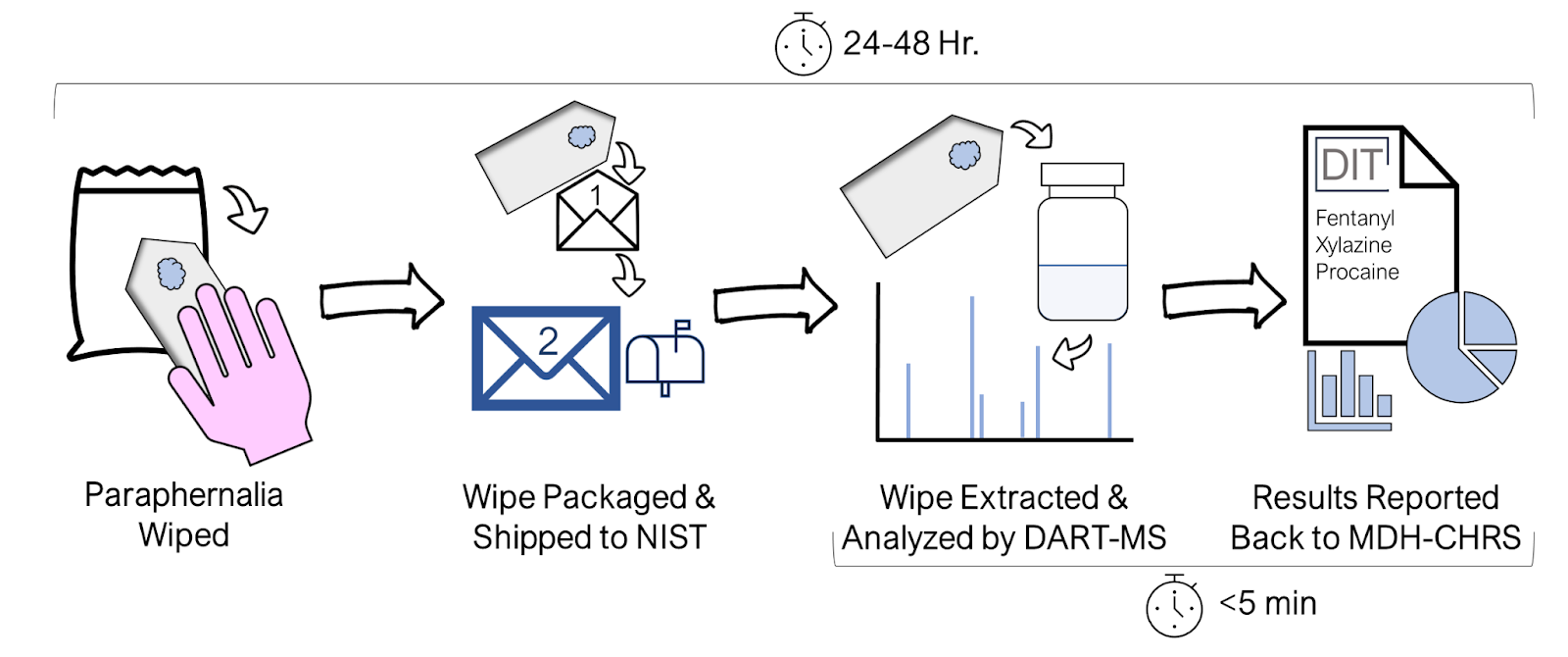Overview
The Rapid Analysis of Drugs (RAD) program tests routine paraphernalia voluntarily provided by Maryland Syringe Services Program (SSP) participants in partnership with the National Institute of Standards and Technology (NIST). Testing results are provided back to SSPs and the participant who submitted the sample. Aggregate data also helps to inform overdose prevention efforts with various local and statewide public health partners.
Since October 2021, over 3,800 samples have been tested among 17 SSPs in 11 jurisdictions.
Background
The
MDH BHA Office of Harm Reduction (OHR) (formerly known as the Center for Harm Reduction Services or CHRS) sought a way to incorporate drug checking into Maryland’s overdose response strategy after experiencing a record number of fatal overdoses in 2020 and 2021.
Growing evidence shows that drug checking services are an effective overdose prevention strategy and can alter behavioral intentions of people who use drugs.
RAD was implemented in October of 2021 through a partnership between OHR and the National Institute of Standards and Technology (NIST).
NIST is a federal physical science laboratory housed within the U.S. Department of Commerce. RAD uses Direct Analysis in Real Time Mass Spectrometry (DART-MS) technology to analyze the composition trace amounts of street drugs.
Legal Framework
The legal framework for RAD is based in
Maryland Health-General Article §24-901 - §24-909.
Here is a helpful handout on
the legal framework of SSPs and RAD in Maryland.
§24–908.
(a) A Program staff member, Program volunteer, or Program participant may not be arrested, charged, or prosecuted for violating § 5–601, § 5–619, § 5–620, or § 5–902(c) or (d) of the Criminal Law Article for possessing or distributing controlled paraphernalia or drug paraphernalia whenever the possession or distribution of the controlled paraphernalia or drug paraphernalia is a direct result of the employee’s, volunteer’s, or participant’s activities in connection with the work of a Program authorized under this subtitle.
(b) Notwithstanding the provisions of subsection (a) of this section, a Program staff member, Program volunteer, or Program participant is not immune from criminal prosecution for any activities not authorized or approved by a Program.
How It Works
RAD allows participants of Maryland SSPs to have used paraphernalia tested for drug composition. A trained SSP staff member wipes the paraphernalia and completes a webform with the participant. Only a trace amount of sample is needed for testing. The webform does not include any personal identifiers and is securely visible to OHR and SSP staff. Collection setting (onsite, mobile unit, street outreach) varies by SSP. The wipe is mailed to NIST, where it is tested using DART-MS. OHR shares results with SSP, and the SSP staff are responsible for sharing the results back to the participant who submitted the sample.

Recent Data
All of the data below comes from the
CY2025 Q2 RAD Newsletter and is current as of 8/15/25. RAD gives us insight into the near real time drug supply in MD, but is not fully representative. RAD is completely voluntary for SSPs and their participants, making it a convenience sample.
In Q2 CY2025, 378 samples were collected from 17 SSPs in 12 jurisdictions.
- The Q2 CY2025 samples contained:
- Opioids (42.9%)
- Of those samples, 88.3% contained fentanyl.
- Cocaine (26.98%)
- Amphetamines (17.46%)
- Medetomidine (8.99%)
- Xylazine (8.47%)
- 36.2% of samples were collected through street outreach or mobile units.
- 30% of samples had multiple active ingredients.
- Identification of emerging substances in MD:
- An increase in sedatives like medetomidine and benzodiazepines was seen in all 12 jurisdictions at varying levels.
- BTMPS (Bis(2,2,6,6-tetramethyl-4-piperidyl) sebacate) - UV light stabilizer with various industrial applications seen in 131 samples from 11 jurisdictions since 10/22
Read more reports
below and find harm reduction resources near you
here.
Maggie Rybak, Program Manager: [email protected]
Janelle Hodgson, Epidemiologist: [email protected]
RAD Reports
2025
2024
2023
2022
Frequently Asked Questions (FAQs)
Does RAD have to be run through a Syringe Service Program?
Yes, because Syringe Service Programs are exempt from Maryland drug paraphernalia laws, staff, volunteers and participants can handle the paraphernalia that is swabbed for testing.
How does my ORP become an SSP?
Learn more about becoming an SSP in Maryland and find the link to apply
here. Find more about becoming an Overdose Response Program (ORP)
here.
How can I test a sample?
Find an SSP that participates in RAD near you
here.
Are there minimum or maximum sampling requirements for SSPs who participate in RAD?
No, there are no minimum or maximum sample requirements. An SSP can send in as few or as many RAD samples as they want.
How is participant information protected?
No Personal Health Information (PHI) or Personal Private Information (PPI) is shared with OHR or NIST. SSP participant privacy is required by Maryland Health-General Article §24-901 - §24-909.
RAD testing results are shared with SSP programs who share both individual results back to the participant that submitted the sample and aggregate results to their communities. Qualitative data (most of which is optional) is collected from participants via webform at the time of testing. This data is stored in a OHR database and only shared back to SSP staff.

